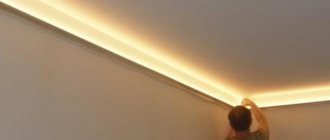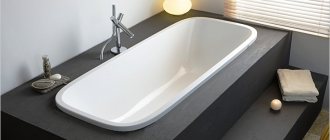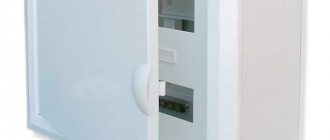Several sockets in one socket box
A modern home is increasingly filled with a variety of electrical appliances and there is a need to use several of them at the same time. That is why double and triple sockets with grounding have become in great demand. This mostly applies to the kitchen. Every housewife will notice the significant convenience of this type of design, since it is not always possible to use an extension cord, plus it is not entirely comfortable.
The installation location plays a huge role; the functionality of the device directly depends on it. If this is a kitchen, it is more convenient to choose a place above the countertop, where most of all electrical appliances are located. In the living room or bedroom, it is good to place a triple socket in the media area, behind the TV or near the computer.
For comfortable operation and beautiful appearance, it is recommended to combine them into one frame consisting of three sockets. But all the insides must correspond to the chosen shape. Manufacturers offer a wide variety of cases, their shapes and colors. You can see suitable options for your interior using the photos of grounded sockets presented.
Installing a triple socket is a little more complicated; in this case, you should have a building level with you so that the device looks neat and level. The structure, according to the instructions, is located at a height of 30-40 cm from the floor.
Advantages of this type of socket:
- They take up less space, there is an option to combine them;
- Economical. The entire mechanism will not cost much more than a regular single socket, but here for the same price, as many as 2 or 3 connectors.
- Ease of use, increases functionality in the home;
- No grommets needed for additional wires.
The disadvantages will be the following facts:
- It will not be possible to make a good fastening in a standard socket box; due to its design, there is a possibility that the socket may fall out. Therefore, it becomes necessary to drill socket boxes for several modules;
- The need for additional tools during installation;
- Installation takes more time and effort, and the formation of dust and dirt is also inevitable.
Installation procedure
Like other elements of open wiring, overhead sockets are quite easy to install yourself. To do this, you can use the following algorithm:
- Turn off the power supply. This is a key point ensuring the safety of all work. If you are not sure which machines are responsible for disconnecting the corresponding line, it would be useful to check the lack of voltage with an indicator screwdriver.
- Perform partial disassembly of the socket. To do this, you need to separate the body from the block. Depending on the design, you will need to unscrew the mounting screw or disassemble the housing and remove the block.
- Mark and secure the socket to the wall. The device is attached to the wooden base using self-tapping screws. For concrete and brick walls you need to use dowels. The device can be screwed to a sheet of drywall with self-tapping screws or special plastic fasteners can be used.
- Prepare a hole for the cable in the socket housing. The hole can be protected with a special elastic plug, which has several optimal diameters. The selected hole is carefully cut with a knife. If there is no such plug, then a hole is broken out in the plastic case along the intended contour. For greater accuracy, you can take a file and cut a hole of the required size, which best matches the cross-section of the cable used.
- Strip the wires to the required length, which is selected based on the design of the clamps on the contacts. This operation should be approached responsibly. There should not be significant stripped areas protruding beyond the fastening, as this may lead to a short circuit. Stripping to a shorter length is also unacceptable, since parts of the insulation getting under the fixing clip can lead to poor contact, overheating of the connection, melting of the block or fire.
- Connect the wires to the terminals. The phase and neutral wires in domestic sockets are connected in random order. If the wiring has a protective neutral, the wires are usually color coded. The phase is marked in white or brown, zero - blue, ground - yellow or green. If there is no color marking, then the task becomes much more complicated, because an indicator screwdriver can only determine the phase. In this case, to determine the protective neutral, you will need a multimeter and a guaranteed grounded element, for example, a steel bath. When measuring, one probe of the tester touches the bathtub body, and the second is connected to one of the three wires. In the voltage measurement mode, the phase wire will show a potential difference of 220 V, the neutral wire - from 0.5 to 6 V, and the protective neutral - 0 V.
- Assemble the socket, apply voltage and check operation.
The use of overhead sockets for open wiring remains relevant. Even if there is hidden wiring, this is the only convenient way to organize additional power points. Careful selection of a high-quality model and proper installation will allow you to create a reliable and safe power supply system.
If the socket box does not fit into the wall
In this case, the repair method is selected depending on what kind of electrical outlet is installed and what the wall is made of.
If the socket box was not “seated” on the mortar, then the size of the hole in the wall is “butt” and it needs to be expanded a little so that there is room to spread the plaster or cement mixture. Next, you need to inspect the socket itself - modern models have slots for threading the cable. They are located over the entire area, and if the putty is pressed through them a little, then this will be an additional fastening. If the socket box is smooth, then you can make notches on its outer side, which the solution will grab onto.
As a last resort, if you don’t have the necessary materials at hand, and it is advisable to repair the socket urgently, then you can simply screw the socket box to the wall with screws. There is only one nuance here - drill holes for the dowels from the corner and place them diagonally so that they do not become loose over time.
In some cases, you can try to fix the falling out socket box with liquid nails, as shown in the following video:
Features of installing overhead sockets on wooden walls
Types of protection for sockets
First, single or overhead triple sockets are selected depending on the number of electrical appliances to be connected (juice extractors, electric meat grinders, electric kettles and much more). Then linings are selected for them, which can be viewed in special sections of the online catalogs Legrand, NaBrevno, etc.
In this case, it is also appropriate to install a corner socket located in a place convenient for connection. Complex socket modules can be included in electrical boxes.
Installation of sockets and switches in a panel house
The advantage of working with a wall chaser is an even groove, no dust
If you have to install power points on concrete walls in panel houses, it is important to consider that monolithic blocks contain reinforcement inside. Therefore, when gating, it is better to use a metal detector
It is prohibited to make channels in load-bearing structures.
To screw a new outlet into place of the old one, which is connected to the power point in the neighboring apartment through the wall, experts recommend proceeding in this way:
- Move the location of the new one slightly, and foam or plaster the joint with the neighbors. Their food point may remain in its old location.
- Extend another power point along the grooves from the existing one.
- Route the new cable from the junction box to install the sockets.
- Connect power to the new power point from the breaker.
- Place the glasses in their old place on a layer of alabaster.
In the same way, you can connect the light in the room, connect the wiring to the switches.
Instructions for installing a surface-mounted socket
Before starting work, we should prepare all the necessary tools. We will need: pliers, a straight or Phillips screwdriver, a pencil, a sharp knife, or better yet, a stationery cutter.
Depending on the material from which the walls are made, you may also need a drilling tool: a drill or a hammer drill. The cable for connecting a surface-mounted socket can be laid hidden, for example, in a wall cavity or groove.
All electrical work must begin with turning off the power supply. To do this, you need to move the machine handles on the electrical panel to the “down” position.
But most often the wire is laid openly: in a cable duct, corrugated pipe, or simply on top of a wall. Regardless of this, the connection procedure is approximately the same. Let's look at all the stages of this process in detail.
Power outage
The first thing you should always do when working with electrical devices is to turn off the power supply. To do this, open the electrical panel and turn off the machines. Most often, this requires moving the position of the handle on the corresponding machine to the “down” position.
You need to know that usually one machine is not “responsible” for all sockets, but only for some part of them. For ease of use, devices are usually signed.
If this is not the case, we can determine the machine we need experimentally. To do this, turn off each circuit breaker one by one and use an indicator screwdriver to check the presence of voltage in the wiring. As soon as it is not there, it means that the required machine has been found.
Those who do not want such experiments can be advised to turn off all circuit breakers on the panel. After making sure that there is no voltage on the wire, you can proceed to the next step.
The method for disassembling the socket depends on its model. In this case, it will be enough to unscrew the fastening screw in the center of the product
As we already know, the socket consists of two main elements: a functional module or mechanism, and a decorative panel - the body. To install the device, you must first remove the housing. To do this, take a Phillips or straight screwdriver, it depends on the model of the socket, and unscrew the central fastening screw on the decorative panel. After this, carefully remove the housing.
Marking the wall and preparing the outlet
Some difficulties with disassembling the outlet may arise if you need to install the device in a moisture-resistant housing. They are distinguished by the presence of a lid that closes the device.
In this case, first open the cover, thus gaining access to the latches that hold the decorative panel of the socket. Then carefully press them out with a screwdriver and disconnect the front panel of the device.
Fastening the socket plate to a concrete or brick wall is done with dowel nails, or to a wooden or plastic surface with self-tapping screws
Now we need to choose a place to install the socket and secure the mechanism to the wall. To do this, take it and apply it to the place where it will be located.
We align the position of the part strictly horizontally, after which we take a pencil and, inserting it into each mounting hole, mark on the plane the points at which the fasteners will be located. We carry out all operations carefully, since an error in the markings will lead to the socket being installed askew.
Fastening the device mechanism
Depending on the material from which the walls are made, the fastening procedure may vary slightly. Let's consider the most common option with a concrete surface.
First, using a puncher or drill, we make holes at the designated points. Their depth and diameter must correspond to the dimensions of the dowels prepared for fastenings.
We place dowels in the holes drilled at the marked points, which will improve the adhesion between the base and the fastener.
We insert dowels into the resulting holes, the so-called plastic plugs that provide the screws with good adhesion to the wall. Then we attach the socket mechanism to the base and securely fix it with screws or self-tapping screws. We check the quality of the resulting fastening. The durability and reliability of the new outlet depends on its strength.
Preparing the wire for connection
Depending on what model of outlet we have, the steps may differ slightly. You may need to route the cable inside the box first.
Most often, sockets of this type have a plug on one side of the body, on which several possible holes of different diameters are identified. In this case, all that remains is to remove the required plug with a sharp knife or cutter and get a hole for the wire.
If there is no plug, it is less convenient, but not hopeless. You must cut the required hole yourself. After this, the wire is inserted into the housing and trimmed so that the length of the remaining segment is sufficient for connection.
The insulation must be cut off from the cable connected to the mechanism. Then we separate each of the cores and strip them down to metal. The length of the exposed core should be 0.8-1 cm.
The cable is cut to the required length. The insulation is removed and the wires are separated, the ends of which are stripped down to metal to a height of about 1 cm
Connecting the mechanism to the cable
When installing overhead sockets, it is important not to make mistakes in connecting the wires. If a two-wire cable is used in the wiring, one of the wires will be zero, the second will be phase. They are connected to different terminals.
A little more complicated with a three-core cable. In this case, the phase and zero are fixed to the outer terminals, and grounding to the central one. Problems do not arise if the person doing the connection knows exactly the designation of the wires, but this is not always the case.
The easiest way to determine zero, phase and ground is if the wiring is color coded. According to this, the working zero or neutral will always be in blue-white or blue insulation, the protective zero or ground will always be in a yellow-green braid.
A wire of any other color, most often red, white, black or brown, will be a phase. Unfortunately, houses with old wiring do not have any color coding.
The photo shows a diagram of connecting the socket mechanism to a three-core cable
In this case, you need to determine which wire is which. This is easiest to do for two-wire wiring. We will need an indicator screwdriver. When it touches a live wire and simultaneously closes the contact, an indicator light on the back of the instrument body lights up.
If this happens, then the phase has been found. The second wire, accordingly, will be the working zero or neutral.
To deal with a three-core cable, you will need a special multimeter. First, you need to disconnect the grounding at the electrical panel. Then determine the phase, and then sequentially “ring” using a device of a pair of wires.
When you simultaneously touch the phase and the working zero, a certain value will appear on the device monitor; when you touch the working and protective zero, no value will appear.
It will be much easier to make a hole for the cable in the socket body if there is such a plug on one of the walls. Dividing into sections with different diameters makes it easy and quick to make a hole of the desired size
Installing a decorative insulating cover
The procedure may vary slightly depending on the surface socket model. If we are dealing with a separately installed case, we insert a mechanism with fixed wires into it, cover it with the front panel and fix it.
If the mechanism and the body are a single unit, replace the decorative panel. If necessary, trim the edge of the housing so that the cable fits in freely. We fix the front panel. Our installation is complete, you can check the operation of the device.
You can learn how to properly plan the location of outlets in the kitchen from the popular article on our website.
Installation of overhead electrical sockets 220 V
So, how is an overhead socket installed? First of all, you need to disconnect the power cable. To do this, open the circuit in the apartment panel using the toggle switch of the input machine. After this, you must make sure that there is no current: just check its absence using an indicator screwdriver.
The next step is to:
- disassemble the device into components. Open the top cover by pressing the fasteners securing the front panel to the base. The result will be three components - the body, the mechanical part and the front panel with a lid;
- mark places on the wall for mounting holes, the number of which depends on the design. The marks are the places where you will need to drill holes for dowel-nails, or simply screw (to a wooden base) a screw holding the parts together;
- release the holes covered by the plug and connect the wires, following the safety regulations. Assemble the socket in the reverse order (securely fasten the mechanism to the base and install the front panel in place). Finally, connect the electricity and check the operation of the connector.
At the stage of finishing work in a log house, many have to face the problem of uneven walls. The best way out of this situation is to install ready-made socket covers on the log itself.
Installing a double socket
It is very important to know how to connect a double socket. There are two types of double hidden sockets:
- There are two sockets in one block. In this option, installing a double socket, there is only one socket and, accordingly, one core. Fastening to connect a double socket occurs in exactly the same way as for a single socket.
- Two connected sockets This option as a hidden double socket is very suitable for rooms. In this option, the installation of a double socket is carried out by installing two socket boxes into the wall. There are special double socket boxes for such tasks. The connection of a block of indoor sockets usually takes place in a series circuit. That is, the first one powers the next one. This option saves the amount of wire, because two sockets can be connected in series. The issue of connecting a triple socket is also resolved.
Degree of protection
Since the installation of a surface-mounted socket is often carried out outdoors, in damp, dirty rooms, the material and design must be strong enough. Each device indicates the possibility of protecting the mechanism from dust and moisture. If the letters IP and two numbers are written on the electrical outlet, then the first number will indicate the degree of protection from solid pollutants, the second - from liquid pollutants.
For wet rooms and streets, it is recommended to buy devices labeled IP44 - IP68. Their body is perfectly protected from all damaging factors; there is a cast body and rubber inserts for sealing. For an apartment, you can buy a socket with a degree of protection of IP21.
Installation and connection of a surface-mounted socket
The wall socket box has a beautiful, protruding body. The socket box will be the decor of the room. It can be decorated with carvings, patterns, drawings, and gold inserts. The decorative body is protected from overheating, is not susceptible to temperature changes, and does not change color due to direct sunlight.
The main difference between a wall-mounted electrical outlet and a standard one is that it is mounted directly on the wall, and not inside. Therefore, installation of a surface-mounted switch socket can be carried out even after completion of the interior finishing. It will not spoil the existing repairs in any way.
Before installing overhead sockets on baseboards, bricks and other surfaces, you need to prepare the equipment. To install switches and sockets I use:
- pliers;
- screwdriver;
- pencil;
- knife or cutter;
- drill.
The cable to the wall outlet can run outside the wall or along grooves.
Socket selection
There are the following types of products:
- standard single - devices up to 7 cm high, up to 5 cm wide, have one input for a plug;
- corner - designed for mounting in a corner;
- standard double - a socket block that has two connectors for plugs;
- electrical sockets with protection - have protective “curtains” that cover the openings;
- decorative devices - devices of low height, varied in shape, size, color (black, blue and others).
When purchasing a product, you need to take into account the voltage (220 V - 240 V), rated current (must meet the requirements of the electrical network). You should also pay attention to the fixation of the wires: screw clamps are the most reliable, while keyboard clamps are less durable and quickly weaken.
Electrical characteristics
In our country, a single-phase electrical network with a voltage of 220 V is used to power most electrical appliances. It is important to pay attention to the voltage markings on the socket body. The operating voltage range of 220−230 V is often indicated. This is a completely acceptable option. However, devices marked 250 V have higher reliability and resistance to voltage surges.
Rated current is the most important characteristic of an outlet. The total power of the devices that can be connected depends on it. Most often, there are models designed for current from 10 to 16 A. Practice shows that even the cheapest copies can be marked 16 A, so this parameter should be assessed in conjunction with the build quality and materials used for the manufacture of the block and contacts. To connect powerful consumers, it is recommended not only to focus on the specified rated current, but also to choose the most reliable models.
Installing outdoor sockets yourself
Almost every room has in its interior an element of electrical equipment such as sockets. You can’t live without them, because whatever you take – an iron or a computer, you need to turn it on somewhere. Due to the ever-growing number of supposedly necessary household appliances, there has become a catastrophic shortage of these same sockets.
In this regard, a certain type of device will be considered below, which is successfully used not only in closed residential premises, but also outdoors in a humid environment.
We will talk about outdoor sockets. They are also called external, for open wiring.
Safety instructions
Connecting wires by soldering
When deciding to connect a built-in module, follow the safety requirements:
- Turn off the electricity and break the circuit.
- Use devices and tools with rubber or plastic insulation on the handles.
- Connect the wires with solder.
- Check the cable insulation and, if necessary, place it in a plastic tube.
- Cut the long strand or twist it into a ring and hide it in the wall.
- Extend a short wire, hiding the contacts.
- To prevent a short circuit, check that the socket and wire match the power and current in the circuit.
- Install the triple module in a wooden house only in a metal socket box.
- Place the module near the door so that the switch is closer to the opening than the socket.
Compliance with safety precautions will help to carry out installation work efficiently.
Sockets in drywall
This is both hidden and open wiring - it belongs to the first category because the wires are not visible, and it falls into the second category because the wires are not walled into the wall and can be reached. In addition to standard tools (unless you are installing a socket block), you will need steel wire for installation. The procedure is as follows:
- The socket and socket box are removed from the wall. They are screwed to the drywall, so there is no need to break anything.
- The steel wire is inserted into the hole and pushed in the direction where the new socket is planned to be installed. At this stage, you just need to make sure that there is a gap between the plasterboard slabs, profiles and the wall into which the corrugation with wire will pass (wiring unprotected from mechanical damage cannot be left inside).
- If you can find the way with the wire, then a hole is drilled in the right place for a new socket box. A strong rope is screwed to the wire and it is pulled back.
- Then, using a rope, a corrugation is pulled between the sockets, the wires are inserted into it and connected.
If it is not possible to stretch the wire between the profiles, then a more radical remedy is used - unscrew a sheet of drywall, stretch the wire and screw it back. All that remains is to putty the damaged joints and install the socket. In some cases, instead of unscrewing the whole sheet, a hole of the desired shape is simply cut out in the drywall (after unscrewing the fastening screws), which is then put in place and puttied.
Installing a Legrand Etika socket: what else do you need to know?
To ensure successful installation, consider several features:
- The decorative overlay does not fasten on its own. It is held in place by the lid and is needed to hide possible defects in the base;
- When removing insulation, make sure that the metal base is not damaged. Even one accidental cut can cause a vein fracture;
- If you place the mechanism on a tree, do not forget to provide a non-flammable base. The fact is that the plastic structure can melt or catch fire. To prevent this from happening, a sheet of aluminum or asbestos is installed between the electrical installation and the wall.
Recommendations for choosing an outdoor electrical outlet.
- When purchasing, keep in mind that they can be single or consist of two, three, four sockets combined in one housing.
- In addition, they can have grounding contacts. For two-wire wiring, take without them.
- For installation outdoors, near the bathroom, washbasin and other places where drops of water are possible, take a sealed version with a lid.
about other parameters that you should pay attention to when purchasing in our separate article “Tips for choosing sockets.”
Source: jelektro.ru











